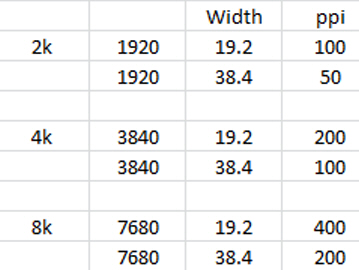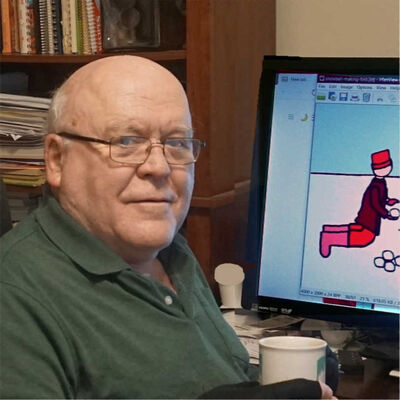Resizing an image can change its character
Apr 27, 2024 10:41:44 #
profbowman wrote:
As to printing, my sense is that one needs to experiment with dpi and desired size to "see" what is the best viewing situation--details seen at a given viewing distance. --Richard
Resolution needed for printing is pretty much a matter of proportions.
There is a consensus that 300ppi is the target to use when printing an 8x12" image that will be viewed from about 10-12" (25-30cm). That's about all that normal eyesight can resolve.
That works out about 8.44MP, maybe all you will ever really need. That's because a person with normal eyesight (or reading glasses) can't look at an 8x12" image from any closer than the normal viewing distance (about the width of the print) without developing eyestrain and a headache.
You print that same 8.44MP image at 8x12 feet and view it from 12 feet away and still see the same level of detail. Change feet to meters and it still works.
The bottom line is that any camera that can capture an image with more than 8.44MP can print any image size you need, so long as you don't crop the image below 8.44MP.
Incidentally, Harrisonburg, VA, is just north of Fort Defiance and the Augusta Military Academy. I was there for about a year in the early 1950s. We marched in a parade in Harrisonburg. I was happy to transfer to a more comfortable school in Miami. AMA now a museum, a pretty spooky place.
Apr 27, 2024 11:04:43 #
Artcameraman
Loc: Springfield NH
selmslie wrote:
I can't imagine any reason to do that. There are a couple of good alternatives that are more straightforward.
I just export the image to a JPEG and use Epson Print Layout (simple and very capable) or Qimage Ultimate (more sophisticated but a little more difficult to use) to print it.
I just export the image to a JPEG and use Epson Print Layout (simple and very capable) or Qimage Ultimate (more sophisticated but a little more difficult to use) to print it.
Yes, I agree, Paint Shop pro.
Apr 27, 2024 14:27:41 #
selmslie wrote:
Resolution needed for printing is pretty much a ma... (show quote)
What you say about print size, resolution, viewing distance is correct, however in practice very few ‘viewers’ do that . Whatever the size of the image people tend to view it Much closer than the distance you suggest.
And many gallery spaces could not accommodate those distances.
So to look their best larger prints can benefit from additional ‘dpi’ instead of 360 dpi some folks go to 720 on Epson large format printers ( those numbers are multiples of the number of nozzles in the Epson print head ( 300/600 for Canon & others
Most top printers are using software RIP’s like Color Byte’s Image print which replaces the Epson driver completely, does extensive layout, and automatic re-sizing
Buy frankly I have found that with Image Print 360 works great and 720 is more of a special case. But I Have seen it work
( I think Lloyd Chambers @diglloyd has done ‘super resolution printing demos but I’m not positive)
Re seeing differences, it is difficult to see subtlety on the internet.
Apr 27, 2024 15:47:29 #
MJPerini wrote:
What you say about print size, resolution, viewing distance is correct, however in practice very few ‘viewers’ do that . Whatever the size of the image people tend to view it Much closer than the distance you suggest.
PPI and DPI are not the same thing.
PPI refers to the number of pixels used to display an image on a monitor. DPI refers to the number of ink dots used to paint an image on a medium like paper.
Common monitor resolutions are 1920 pixels (2k) and 3940 (4k). PPI is calculated by dividing the monitor pixel width by the width of the display in inches.
Based on normal visual acuity, 300ppi is considered the highest resolution that a human eye can perceive as sharp from about 10". From 15" it is 200ppi and from 20" it is 150ppi.
My eyes are old and I use readers because I chose to prioritize long distance vision when I had my cataracts removed.
I have two monitors that are about 24" wide. I can distinguish the separate pixels on the 2k monitor (82ppi) if I get close enough, but I can't work any closer than 15" from the screen. With the 4k monitor (157ppi) I can't really see the separate pixels from 15".
The arbitrary 300ppi standard viewed from 10" is conservative. It's also the basis for DOF calculations.
I doubt that any viewer is going to get within 10" of a print to judge whether it is sharp.
DPI is ink dots per inch. Printers use much higher dpi values to create a print. The Epson P900 has a maximum resolution of 5760 x 1440 dpi. It takes a lot of ink dots to represent the content of a single pixel. The multiple dots make it possible to achieve subtle colors.
The only way they come together is if you don't have enough ppi to generate a sharp image with the ink dots.
That ppi is inversely proportional to the distance from which the viewer is going to look at the image. But a printer used to create very large prints does not need as many ppi as a normal photographic printer. You can create a billboard sized print using a very low ppi so long as the viewer is not likely to get too close.
Hypothetical monitor resolutions

Apr 28, 2024 06:14:22 #
Artcameraman
Loc: Springfield NH
selmslie wrote:
PPI and DPI are not the same thing. br br PPI r... (show quote)
Yes, but I use a blad with "fat Pixels".
Apr 28, 2024 06:18:45 #
Artcameraman
Loc: Springfield NH
Artcameraman wrote:
Yes, but I use a blad with "fat Pixels".
Viewing distance has to be considered when printing any file, resolution of 360 dpi is now considered standard. However this is not possible on my 9600 where 300 is the max. I have to pull paper off the roll and let to drup in order for it to feed, true the newer printers don't have this.
Apr 30, 2024 14:33:32 #
selmslie wrote:
Resolution needed for printing is pretty much a ma... (show quote)
Yes, you have given us a good calculation to remember. I do remember reading somewhere about a dpi requirement of 600 being stated. Maybe it was one of my book publishers. Anyway, with my poor eyesight, I can never count on framing a photo as I want it in my camera. So, I am glad that I have a 24MB camera allowing me to cut my photo dimensions from 6000 x 4000 to 3000 x 2000 pixels and still get a printable image.
As to your experiences with the Augusta Military Academy, as an Anabaptist Christian, I am a strong conscientious objector to participating in war. Having worked as a supervisor of boys who were defined as juvenile delinquents back in the late 1960s and seeing how the "state" and several of the other supervisors treated them, I am convinced that there are better ways to "redeem" our youth than by using aggressive force. Well, we could talk aboout that more but not here. --Richard
Apr 30, 2024 16:13:30 #
profbowman wrote:
Yes, you have given us a good calculation to remember. I do remember reading somewhere about a dpi requirement of 600 being stated. ...
Early black ink dot-matrix and laser printers used 600dpi as the standard to produce text that was as good or better than what you could get from ordinary typewriters. Teletypes and other machines for typing text from computers were much more crude.
Although 600dpi was better than 300dpi for text, it was not good enough for printing gray scale images. It didn't work for color images.
If you want to reply, then register here. Registration is free and your account is created instantly, so you can post right away.

